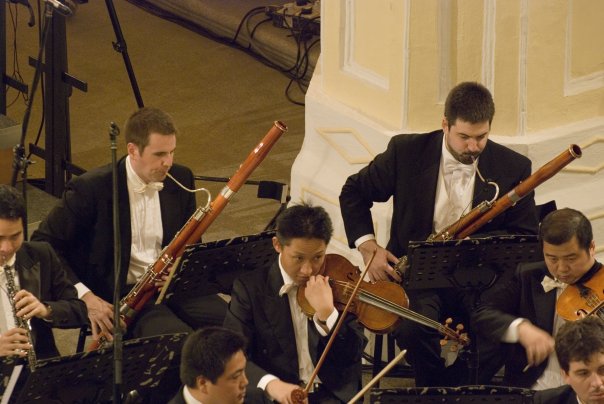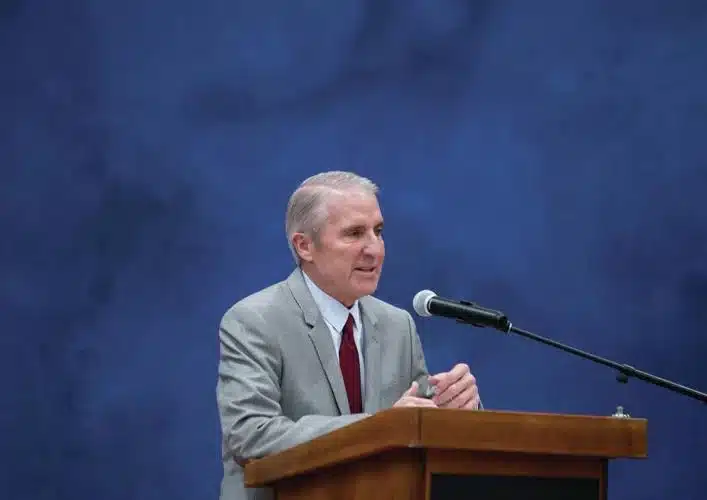A full assessment of the Covid risk of playing wind instruments
mainDr Adam T Schwalje, Resident Physician , Otolaryngology – Head and Neck Surgery at University of Iowa Hospitals and Clinics, has been working on a full assessment of the risk of speading Covid-19 by playing wind and woodwind instruments.
Together with his colleague Dr Henry T Hoffman, Dr Schwalje, who is himself a wind player (pictured), has written this paper for publication in medical journals. You read it here first.
Take your time. Do not rush to the conclusions.
Wind Musicians’ Risk Assessment in the Time of COVID-19
Adam T Schwalje MD, DMA; Henry T Hoffman MD
10 June 2020
COVID-19 is a severe and dangerous disease. Its heart-wrenching infectivity and virulence hit home for many musicians, as we learned of the several choirs which were affected by superspreading events early in the pandemic. One was in Amsterdam, where 102 of 130 participants wound up with coronavirus infection; one in Washington state, where 52 of 60 participants were infected, and at least two others in Europe. Several choir members unfortunately died as a result. These were early hints that singing itself might be risky. The risks were strong enough that an alarm was raised by Dr. Lucinda Halstead and others in a National Association of Teachers of Singing webinar (NATS), leading many including the Metropolitan Opera to forego their upcoming seasons.
Because of similarities to singing, there is concern that wind players might also be at additional risk, above the background risk, for spread of COVID-19. It is vitally important to be clear about the current uncertainties in COVID-19 risk assessment for the wind instrumentalist.
Background
Novel coronavirus continues its rapid spread throughout the world. Infections with SARS-CoV-2 are increasing and number more than 7.3 million worldwide, with over 400,000 deaths reported as of 10 June 2020 (Dong et al.). There are likely many more infections than reported due to well-publicized issues with testing and the high prevalence of asymptomatic infection.
The pandemic is serious and deadly. More than 1 in 3000 Americans have died from the disease thus far. Symptoms are gradual in onset and flu-like, however, many infected individuals are asymptomatic or presymptomatic and still infectious (Gandhi et al.). It is likely that COVID-19 is several times more deadly than influenza, which itself is a dangerous disease (Faust et al.). Most deaths from COVID-19 are in those who are elderly and / or have comorbidities including high blood pressure or diabetes (Parohan et al.). However, over 15 percent of US deaths, numbering over 17000, have been in those younger than 65 years (National Center for Health Statistics, updated 3 June 2020). Significant disease is also possible in children and teens (e.g., Licciardi et al.).
Spread of SARS-CoV-2 is mostly by droplets or aerosol. The larger droplets can deposit on surfaces. Smaller droplets and aerosols can hang in the air and remain infectious. The smallest aerosols may lead to more serious disease, as they can be inhaled further into the lungs (Meselson). The 6-foot radius of safety is commonly mentioned as this is a distance over which larger droplets will not remain airborne. But, if an infected individual is coughing in a small room, for example, the air in the room can remain infectious for some time (Meselson).
Musicians and SARS-CoV-2
K-12 programs, collegiate programs, and orchestras are struggling to imagine how they might survive the tremendous challenges represented by COVID-19. Despite the ongoing pandemic, a few orchestras are already back to work, and many music programs and ensembles are making plans to resume operations.
It is understandable to wonder what the additional risks are for wind musicians, above the nonzero background risk of COVID-19 spread. How might we mitigate these risks for ourselves, our colleagues, audiences, students, and families? Some groups have put out detailed guidelines which purport to reduce risk of transmission of SARS-CoV-2 (personal communication). Others have put out blanket statements, for example that “any potential risk of infection or transmission of the virus [from wind playing] is essentially gone as long as proper social distancing and other precautions are being observed” (Nashville Music Scoring, 2020). The risks are unknown, but they are assuredly not zero.
Scientific and Ethical Underpinnings
It is more important than ever to read studies and guidelines with a critical eye and keep in mind the basics of scientific inquiry. A scientific study would cite sources, would be peer reviewed, in the case of COVID-19 would have the input of a physician or infectious disease specialist, and would be clear about who is producing the study and any conflicts of interest. The ability to replicate results is crucial, though this aspect of scientific inquiry can take time. Musicians who do rely on the conclusions of non-reproducible studies might underestimate either the risks of their activities or the uncertainty involved in assessment of these risks. Unfortunately, there are several recent, widely-circulated, pseudoscientific assessments of risk and risk mitigation strategies for wind musicians. The good news is that there are several scientific studies on these questions also, most of which are still ongoing.
If we assume there’s no risk, or if we assert that unstudied risk mitigation procedures work, then people can’t make an informed decision about whether to put themselves in those potentially risky situations. Also, if there is at least an acknowledgement of risk, then those who are at greater personal risk from COVID-19 (the elderly, those with comorbidities, etc.) may be able to seek accommodations for risk mitigation from their local governments. In the US, for example, this might be accomplished through the Americans with Disabilities Act (EEOC).
Specific Risks of Wind Playing
- The Issue of Aerosols
Much attention has been given to the risks of singing, largely because of early superspreading events. The mechanism of singing requires deep breathing, vibration of the vocal folds, active manipulation of the larynx, pharynx, tongue, and lips, and produces aerosols which can hang in the air for at least hours. Some individuals produce significantly more aerosol than others, for unknown reasons (Asadi).
Risks of playing a wind instrument are probably different than those involved in singing, though there are similarities. The flute, for example, creates a strong airflow, though other instruments do not. But airflow does not tell the whole story. Playing a wind instrument involves deep breathing, sometimes forceful exhalation, and possible aerosolization of the mucus in the mouth and nose, along with secretions from deeper airway structures. The only peer-reviewed, published study on a wind “instrument” and aerosolization investigated the vuvuzela and found significant aerosol production (Lai et al.). There is, therefore, at least a theoretical risk of droplet or aerosol transmission during wind performance, but more study needs to be done.
Two oft-referenced recent studies, one from Vienna Philharmonic and one from Freiburg University, investigated airflow and wind instrument playing (Vienna Philharmonic; Spahn et al.). Neither of these were peer-reviewed or published in a journal. Neither of these addressed aerosol generation, which is the main issue, as aerosols can hang in the air for extended periods of time and can be infectious. Dispersion of aerosols was hinted at in both studies, but dispersion is dependent on external factors like room airflow and mixing dynamics, which were not examined in either paper. A lack of evidence about aerosol generation and elements of aerosol dispersion is explicitly noted in the Freiburg review. Even if there is minimal airflow from playing, if aerosols are produced especially in the context of deep breathing, there is a risk of spreading the aerosols around the environment. This risk is not quantifiable at the moment. Several centers in the US are investigating aerosol production from wind instrumentalists; these include University of Colorado at Boulder, Colorado State University, Rice University, and University of Maryland.
Other behaviors associated with wind playing might also be risky: Wind players buzz on their mouthpieces, blow out tone holes, blow out spit valves, clean their instruments with swabs and feathers, and might have leaking embouchures or nasal emissions during playing. How to mitigate these risks is not yet known, though many approaches have been suggested and are even being put into use. One example is the use of disposable rags to blow out spit valves for brass musicians. This is intuitively cleaner and less likely to spread infection than, for example, emptying them onto the bare floor for everyone to track around – but the potential for aerosolization if any force is used to expel the contents, for example, is not known. Another strategy is use of shields of plexiglass surrounding wind players. This strategy has not been studied for wind musicians, but is reminiscent of (though not entirely similar to) the idea of using polycarbonate face shields to protect healthcare workers from aerosol spread – effective in the short term to protect from an infected patient coughing in one’s face, but after 30 minutes during which aerosols mixed with surrounding air the face shield was found to be ineffective (Lindsley et al.).
The risk of aerosol production posed by wind instrument performance is not known, though there are several indications that it might exceed background risk of COVID-19 transmission. Studies on this risk, and the effectiveness of risk mitigation strategies, have not yet been completed.
- Reeds
Reedmaking is a large part of many people’s livelihoods. But, it is very important to recognize that there are no guidelines, no US Centers for Disease Control (CDC) recommendations, no EPA or FDA recommendations, and very little science, which specifically supports or instructs on how to make a reed safe from coronavirus. There is no validated method that will eliminate the risk of viral transmission from reeds. The safest approach would be to treat all reeds as if they are infectious; to not work on others’ reeds and not share reeds with others. This can be difficult, especially for double reed players.
CDC guidelines which have been referenced by some reedmakers, like the suggestion for a soak in 70% alcohol, are designed for disinfecting already clean surfaces (CDC). Unfortunately, reeds are not like other typically-studied surfaces. Played-upon reeds include proteins, respiratory secretions, and dead skin, in addition to the structure of the reed itself – all of which would probably tend to stabilize the virus (based on studies of SARS-CoV1, Geller et al.). The CDC has no recommendations on how long, or with what, to soak or process a reed to render it safe from coronavirus.
There is some timeframe, of unknown duration, during which virus particles deposited on and in a reed will lose their ability to infect a new host. Unfortunately, it is unclear how long coronavirus particles remain infectious on or in items like reeds. The closest available comparison is with cardboard, on which virus particles seem to have a relatively short time of remaining infectious (24h compared to 72h + for solid surfaces, van Doremalen et al.). But, one review concluded “the most common coronaviruses may well survive or persist on surfaces for up to one month.” (Ren et al.). In any case, the materials tested to draw these conclusions are not soaked in someone’s mouth for hours on end, and these types of tests generally exclude presence of other substances like proteins. Therefore, applicability to reeds in a real-world situation is unknown.
Another theoretical option for reed disinfection is a high-temperature soak (e.g., at 77 degrees C or 170 degrees F, for 30 min), which is more conservative than the 30 minutes at 65 degrees C used for heat inactivation of commercially available SARS-CoV2 (provided in a protein-rich serum, https://www.beiresources.org/Catalog/antigen/NR-52286.aspx). This might be a way to ensure that the entire reed is disinfected – though this method has yet to be validated.
For cleaning and disinfecting reedmaking equipment, a reedmaker might be able to use resources like: https://www.cdc.gov/coronavirus/2019-ncov/prepare/cleaning-disinfection.html or https://www.epa.gov/pesticide-registration/list-n-disinfectants-use-against-sars- cov-2. Knives and other reed tools should be treated like food preparation equipment; potentially dangerous chemicals should be removed from their surfaces before use.
Putting one’s mouth on a reed which has been sucked on by another person is not without risk in the COVID-19 era. It is impossible to quantify this risk. It is likely that some procedure like heating in water or waiting for a specified time decreases this risk, but it is impossible to say how much the risk is reduced with this or any other method. To support those who choose to wait for some length of time before using a reed which has been played by others, reeds should be marked with their date of last play-testing. Using a “sanitizing procedure” could give a false sense of security but is probably better than doing nothing, if there is no alternative to sharing.
- Music Education
Those players who are less experienced are more likely to have leakage of air around the embouchure, more likely to have stress velopharyngeal incompetence or nasal emissions, and are likely to work harder to produce sound – all of which may create more risk of aerosol production and subsequent COVID-19 spread.
Practice rooms are small spaces which might easily be filled with aerosol. These particles may take hours to settle and could still remain infectious on surfaces even when settled from the air. Appropriate ventilation and cleaning precautions should be used, with some minimum time required before cleaning and re-use.
In K-12 school music and collegiate methods courses, sharing and storage of instruments present another set of challenges. While brass instruments can probably be effectively cleaned using the CDC guidelines for surfaces, using an instrument brush / hot soapy water for cleaning followed by a disinfectant wash, it is unclear how other instruments, made of delicate woods, felts, and corks, can be cleaned or disinfected. Careful management of a full class of school-age recorder players, in this context, would be difficult. The instrument storage room presents additional possibilities for spread of potentially infectious droplets.
Unknown risks
The risks of wind playing in the COVID-19 era are unknown. There is a possibility, currently being studied, that the risks of wind playing and associated behaviors are greater than baseline risk of spread of COVID-19. This has wide ramifications as programs are attempting to re-open. Acknowledging the risks and attempting to mitigate them is important – but should not lull musicians into a false sense of security. Unfortunately, the available scientific evidence is too scant to reliably inform decisions about risk mitigation strategies for wind musicians. Musicians should be empowered to make their own decisions based on their individual risk tolerance. Leaders should be cautious in their representations of risk and clear about uncertainty regarding the efficacy of risk mitigation strategies.
About the Authors
Dr. Adam Schwalje is a resident physician and National Institutes of Health (NIH) T32 research fellow in the Department of Otolaryngology at the University of Iowa Hospitals and Clinics (UIHC). In addition to his work as a physician, he holds the DMA in bassoon performance from the University of Cincinnati College – Conservatory of Music, where he studied with the late William Winstead. Adam has played in professional orchestras including full time in the Macau Symphony. He has also been a band teacher and music educator, and is currently the medical liaison for the International Double Reed Society.
Dr. Henry Hoffman is Professor of Otolaryngology at the University of Iowa Hospitals and Clinics (UIHC). He graduated from the University of California, San Diego School of Medicine and completed his otolaryngology residency at the University of Iowa with subsequent fellowships in head and neck surgery and facial plastic surgery. He is Director of the Voice Clinic and is extensively involved in research addressing laryngeal pathophysiology. He is creator and editor of the Iowa Protocols (https://medicine.uiowa.edu/iowaprotocols/) and has published over 200 scientific works. His bands, occasionally including bassoon, can be heard throughout southeast Iowa.
This article has not been peer reviewed. There is no external funding source. It represents the general opinions of Drs. Schwalje and Hoffman and is not intended to offer or replace specific medical advice. If you have questions about your medical situation or your specific risks regarding COVID-19, please contact your physician.
References
Dong, E., Du, H., & Gardner, L. (2020). An interactive web-based dashboard to track COVID-19 in real time. The Lancet. Infectious diseases, 20(5), 533–534. https://doi.org/10.1016/S1473-3099(20)30120-1. https://coronavirus.jhu.edu/map.html accessed 10 June 2020.
NATS National Association of Teachers of Singing (5 May 2020). https://www.youtube.com/watch?v=DFl3GsVzj6Q accessed 8 June 2020.
Gandhi, M., Yokoe, D., & Havlir, D. (2020). Asymptomatic Transmission, the Achilles’ Heel of Current Strategies to Control Covid-19. The New England Journal of Medicine, 382(22), 2158-2160.
Faust JS, del Rio C. Assessment of Deaths From COVID-19 and From Seasonal Influenza. JAMA Intern Med. Published online May 14, 2020. doi:10.1001/jamainternmed.2020.2306.
Parohan M, Yaghoubi S, Seraji A, Javanbakht MH, Sarraf P, Djalali M. Risk factors for mortality in patients with Coronavirus disease 2019 (COVID-19) infection: a systematic review and meta-analysis of observational studies [published online ahead of print, 2020 Jun 8]. Aging Male. 2020;1‐9. doi:10.1080/13685538.2020.1774748.
National Center for Health Statistics (updated 3 June 2020). https://data.cdc.gov/NCHS/Provisional-COVID-19-Death-Counts-by-Sex-Age-and-S/9bhg-hcku accessed 7 June 2020.
Licciardi, F., Pruccoli, G., Denina, M., Parodi, E., Taglietto, M., Rosati, S., & Montin, D. (2020). SARS-CoV-2-Induced Kawasaki-Like Hyperinflammatory Syndrome: A Novel COVID Phenotype in Children. Pediatrics, Pediatrics, May 21, 2020.
Meselson, M. (2020). Droplets and Aerosols in the Transmission of SARS-CoV-2. The New England Journal of Medicine, 382(21), 2063-2063.
Nashville Music Scoring (2020). Brass & Woodwinds Air projection. youtube.com/watch?v=K5Yu4ll8JGg&t=6s, accessed 7 June 2020.
EEOC US Equal Employment Opportunity Commission (updated May 7 2020). What You Should Know About COVID-19 and the ADA, the Rehabilitation Act, and Other EEO Laws. https://www.eeoc.gov/wysk/what-you-should-know-about-covid-19-and-ada-rehabilitation-act-and-other-eeo-laws accessed 8 June 2020.
Asadi S, Wexler AS, Cappa CD, Barreda S, Bouvier NM, Ristenpart WD. Aerosol emission and superemission during human speech increase with voice loudness. Sci Rep. 2019;9(1):2348. Published 2019 Feb 20. doi:10.1038/s41598-019-38808-z.
Lai KM, Bottomley C, McNerney R. Propagation of respiratory aerosols by the vuvuzela. PLoS One. 2011;6(5):e20086. doi:10.1371/journal.pone.0020086.
Vienna Philharmonic (2020). Aerosolausstoßtest: Geringes Infektionsrisiko durch die Verbreitung von Atemluft von Musikern [Aerosol Emissions Test: Low Risk of Infection through Musicians’ Breath]. https://www.wienerphilharmoniker.at/orchester/philharmonisches-tagebuch/year/2020/month/4/blogitemid/1423/page/1/pagesize/20?fbclid=IwAR2wCggWqcd-Q_8Ewzr3E8rwX3_RxWKOpQXo3hMkDpag04O-YY9BDfPE8qQ, accessed 8 June 2020.
Spahn C, Richter B, Leitung des Freiburger Institut für Musikermedizin (FIM), Universitätsklinikum und Hochschule für Musik Freiburg (updated 19 May 2020). Risikoeinschätzung einer Coronavirus-Infektion im Bereich Musik [Risk assessment of a coronavirus infection in the field of music – second update of 19 May 2020]. https://www.mh-freiburg.de/en/university/covid-19-corona/risk-assessment, accessed 8 June 2020.
Lindsley WG, Noti JD, Blachere FM, Szalajda JV, Beezhold DH. Efficacy of face shields against cough aerosol droplets from a cough simulator. J Occup Environ Hyg. 2014;11(8):509‐518. doi:10.1080/15459624.2013.877591.
CDC Center for Disease Control and Infection (2020). Cleaning and Disinfecting Your Facility. https://www.cdc.gov/coronavirus/2019-ncov/community/disinfecting-building-facility.html, accessed 8 June 2020.
Geller, C., Varbanov, M., & Duval, R. E. (2012). Human coronaviruses: insights into environmental resistance and its influence on the development of new antiseptic strategies. Viruses, 4(11), 3044–3068. https://doi.org/10.3390/v4113044.
van Doremalen, N., Bushmaker, T., Morris, D. H., Holbrook, M. G., Gamble, A., Williamson, B. N., Tamin, A., Harcourt, J. L., Thornburg, N. J., Gerber, S. I., Lloyd-Smith, J. O., de Wit, E., & Munster, V. J. (2020). Aerosol and Surface Stability of SARS-CoV-2 as Compared with SARS-CoV-1. The New England journal of medicine, 382(16), 1564–1567. https://doi.org/10.1056/NEJMc2004973.
Ren, S. Y., Wang, W. B., Hao, Y. G., Zhang, H. R., Wang, Z. C., Chen, Y. L., & Gao, R. D. (2020). Stability and infectivity of coronaviruses in inanimate environments. World journal of clinical cases, 8(8), 1391–1399. https://doi.org/10.12998/wjcc.v8.i8.1391.

Many thanks to James Massol DMA and Sasha Garver DMA for their thoughtful comments





Comments